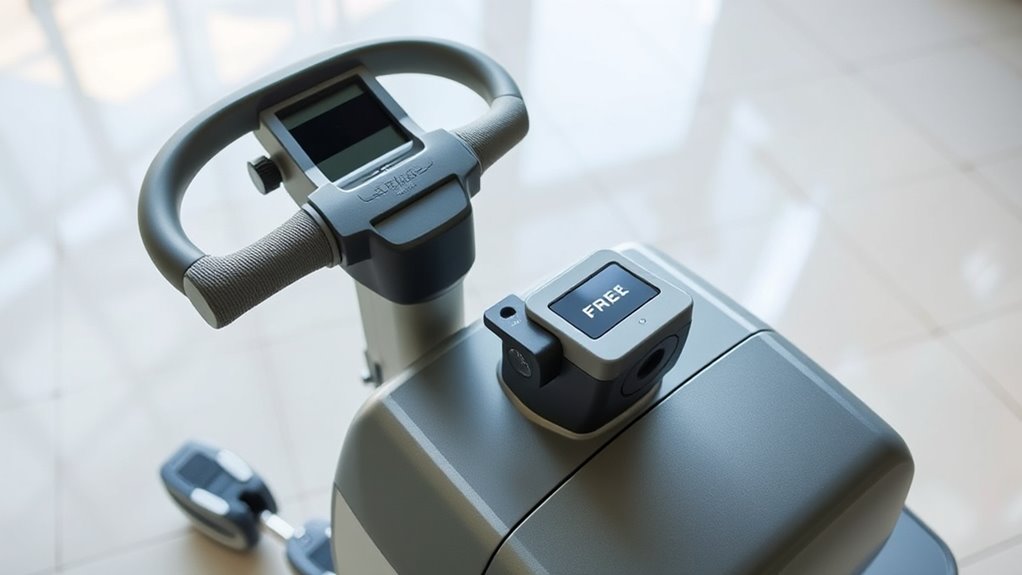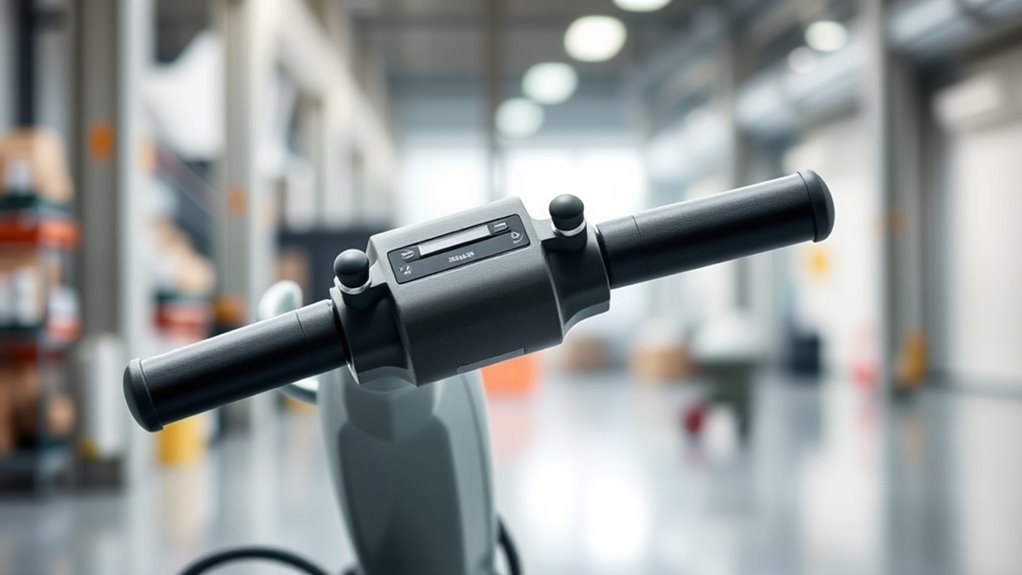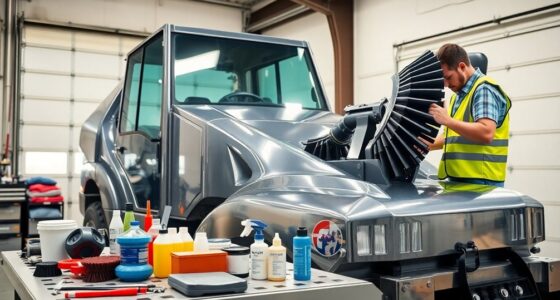Ergonomics in specialty floor machines is essential for your safety and efficiency. Well-designed machines keep controls within easy reach, adjust to your height, and reduce physical strain with padded grips and anti-vibration features. Proper layout and weight distribution make handling easier and prevent fatigue. When you work with ergonomically designed equipment, you can operate longer comfortably, respond faster to emergencies, and stay focused. Keep exploring to discover how these features can boost your performance even further.
Key Takeaways
- Ergonomic design improves operator safety and reduces fatigue during prolonged use.
- Adjustable handles and controls enhance comfort for diverse operator heights and preferences.
- Proper layout of gauges and switches minimizes awkward movements and risk of injury.
- Features like padded grips and anti-vibration reduce physical strain and improve control.
- Ergonomics in machine design boosts efficiency, focus, and overall operational safety.

When it comes to floor machines, prioritizing ergonomics isn’t just about comfort — it’s vital for safety and efficiency. As someone operating these machines daily, understanding how ergonomic design impacts your safety is essential. Well-designed machines reduce fatigue, minimize the risk of injury, and guarantee you can work longer without discomfort. Good machine design places controls within easy reach, uses intuitive layouts, and minimizes unnecessary movements, all of which contribute directly to operator safety. If a machine’s design forces you to adopt awkward postures or reach excessively, it increases strain on your muscles and joints, raising the chances of repetitive strain injuries or accidents. Consequently, selecting equipment with ergonomic considerations in mind isn’t just a comfort choice; it’s a safety imperative.
Modern floor machines are built with operator safety at the forefront by integrating ergonomic features. Handles are adjustable to accommodate different heights, helping you maintain a natural posture. This reduces back and shoulder strain, especially during prolonged use. Controls are often designed to be easily accessible and responsive, allowing you to operate the machine smoothly without exerting extra force or awkward movements. Some models even include padded grips or anti-vibration features to lessen fatigue and improve grip stability. These thoughtful design elements prevent you from overexerting yourself and help maintain focus, which is critical for avoiding accidents. When machine design emphasizes ergonomics, it fosters a safer working environment because you can respond quickly and confidently to operational needs without distraction or discomfort.
Additionally, ergonomic principles influence the overall layout of the machine, making routine tasks more straightforward. For example, well-placed gauges, switches, and safety features ensure you’re not forced to stretch or twist your body in unsafe ways. This thoughtful placement minimizes the risk of slips, trips, or mishandling during operation. Ergonomic design also considers the weight distribution of the machine, making it easier to maneuver and control, especially on uneven surfaces. When you’re less fatigued and more comfortable, your reaction times improve, and your ability to operate the equipment safely increases. This proactive approach to machine design ultimately enhances operator safety and boosts productivity. Incorporating ergonomic considerations in the design process further ensures that safety is prioritized alongside efficiency.
Frequently Asked Questions
How Do Ergonomic Features Vary Between Different Brands?
Different brands vary in ergonomic standards and design innovations, which directly impact your comfort and efficiency. Some prioritize adjustable handles, cushioned grips, and lightweight construction, making operation easier and reducing fatigue. Others incorporate advanced features like intuitive controls and ergonomic shape designs. By comparing these ergonomic features, you can choose a machine that minimizes strain and enhances your productivity, ensuring a safer, more comfortable working experience.
What Are the Long-Term Health Benefits of Ergonomic Design?
Think of ergonomic design as a sturdy bridge supporting your long-term health. By improving your posture and reducing strain, it helps prevent injuries that could otherwise accumulate over time. The long-term health benefits include less back pain, fewer repetitive strain injuries, and better overall comfort. Embracing ergonomic features means you’re investing in your well-being, ensuring you stay strong, pain-free, and productive well into the future.
How Can Users Customize Ergonomic Settings for Comfort?
You can personalize ergonomic settings for comfort by adjusting the handles and seat to fit your body. Use the adjustable handles to set the height and angle, reducing strain on your arms and shoulders. Also, customize the seat height and position to guarantee proper posture and support during operation. These adjustments help prevent fatigue and discomfort, making your work easier and more efficient over long periods.
Are Ergonomic Enhancements Cost-Effective for Small Businesses?
Like a trusty steed in a joust, ergonomic enhancements are definitely cost-effective for small businesses. A proper cost analysis shows that investing in ergonomic features boosts employee productivity and reduces injury-related downtime. While initial costs might seem high, the long-term savings in health claims and turnover outweigh them. In the end, prioritizing ergonomic improvements pays off, making your team more efficient and your business more resilient.
What Training Is Recommended for Proper Ergonomic Use?
You should attend ergonomic training that focuses on proper handling techniques and correct posture to guarantee user comfort. This training helps you understand how to adjust the machine for your body size and minimize strain during operation. By practicing these techniques regularly, you’ll improve user comfort, reduce fatigue, and prevent injuries. Consistent ergonomic training is essential for safe, efficient use of specialty floor machines, especially during long or repetitive tasks.
Conclusion
As you operate the specialty floor machine, imagine gliding smoothly across a gleaming, spotless floor, your posture steady and comfortable. Proper ergonomics support your every move, reducing fatigue and preventing strain. Feel the control in your hands, the machine responding effortlessly to your touch. With the right setup, each task becomes a seamless dance, leaving your workspace pristine and your body energized. Embrace ergonomic principles, and transform cleaning into a confident, smooth-flowing routine.









